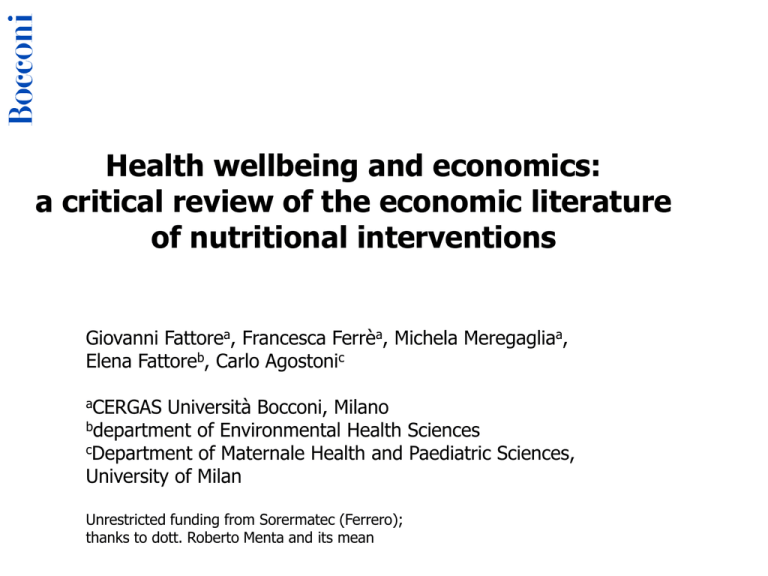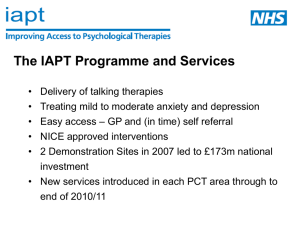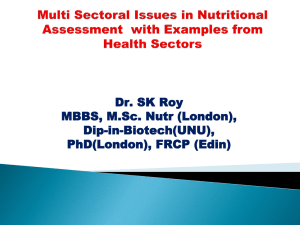Giovanni Fattore – Health wellbeing and economics
advertisement

Health wellbeing and economics: a critical review of the economic literature of nutritional interventions Giovanni Fattorea, Francesca Ferrèa, Michela Meregagliaa, Elena Fattoreb, Carlo Agostonic aCERGAS Università Bocconi, Milano bdepartment of Environmental Health Sciences cDepartment of Maternale Health and Paediatric Sciences, University of Milan Unrestricted funding from Sorermatec (Ferrero); thanks to dott. Roberto Menta and its mean De Gustibus Disputandum Non Est Nutrition & Health Economics 11° World iHEA Conference July 12-15 2015 Introduction • Lifestyle changes related to diet have the potential to improve health and reduce healthcare costs associated to obesity and other diet-related conditions (e.g. CVDs, diabetes, cancer) • Nutrition education is the traditional instrument adopted at individual (i.e. counselling) or population level (e.g. mass-media campaign, school-based interventions) to encourage healthy eating • In recent years, new strategies have been implemented both at national and local level • Examples of such policies in the US include bans on the use of trans fats in restaurants, taxes on sugary drinks and a proposal to limit the sale of large sugary drinks (Barnhill and King, 2013) • Food taxes - the so called ‘obesitax’ - have been proposed in several European countries (i.e. Denmark, France, Hungary, United Kingdom) (Devisch, 2013) Introduction • The evidence about the effectiveness (‘does it work?’) and costeffectiveness (‘is it worth the money’?) of such interventions is often limited • Traditional counselling programs face the issue of individuals’ adherence to the recommended diet and retention of health benefits in the long term • To date fiscal policies (taxes and subsidies) have been driven largely by imperatives to rise revenue or increase supply rather than to change population behaviours (Moodie et al., 2013) • Moreover, cost consequences needed to be included in economic evaluations of nutrition interventions may be broader than usually applied in healthcare (e.g., individual food expenditure, agriculture productivity) (Lenoir-Wijnkoop, 2011) • Some policies (e.g., excluding unhealthy food from food assistance programs) may also have undesirable consequences from an ethical and social point of view (Barnhill and King, 2013; Devisch, 2013) Introduction and objective of the study • The increasing interest in policy actions aimed at improving people diet suggests the crucial role of economic analysis of nutrition interventions (Wong et al., 2011; Nuijten, 2011) • The aim of our study is to summarize and critically assess economic evaluation studies conducted on interventions (directly or indirectly) aimed at voluntary dietary improvements • We consider a number of nutrition interventions expected to stimulate individuals to modify their nutrition behaviour (e.g. nutritional counselling, information campaigns, food labelling and fiscal measures) Methods • We perform a systematic literature review following the PRISMA statement (Preferred Reporting Items for Systematic Reviews and Meta-Analyses) • Three electronic databases are searched: PubMed, OVID Medline and EMBASE • A combination of diet-related keywords (i.e., fat, diet, intake, nutrition) and economic-related terms (i.e., cost-effectiveness, costutility, cost-benefit, health economics, economic evaluation) are used • The search is performed on titles and abstracts only; we filtered only English full-text papers and literature published up to March 31, 2013 • All database search results are imported into EndNote software (version 6) for the purpose of identifying duplicate papers and title/abstract screening Methods Papers are considered for inclusion if they: • • • address voluntary diet interventions (either positive actions – i.e., introducing or increasing the consumption of a healthy food, or negative actions – i.e., eliminating or reducing the consumption of a harmful food) report an economic evaluation of any sort (i.e. documenting both clinical outcomes improving wellbeing and information about use of scarce resources - costs) are original studies (i.e., no review articles, meeting abstracts, editorials) Studies are assessed using the standard “checklist” for critical appraisal of economic evaluation studies (Drummond, 2005) complemented with the Consensus on Health Economic Criteria CHEC-list focusing on the quality of economic evaluations (Evers et al., 2005) Methods Papers are considered for inclusion if they: • • • address voluntary diet interventions (either positive actions – i.e., introducing or increasing the consumption of a healthy food, or negative actions – i.e., eliminating or reducing the consumption of a harmful food) report an economic evaluation of any sort (i.e. documenting both clinical outcomes improving wellbeing and information about use of scarce resources - costs) are original studies (i.e., no review articles, meeting abstracts, editorials) Studies are assessed using the standard “checklist” for critical appraisal of economic evaluation studies (Drummond, 2005) complemented with the Consensus on Health Economic Criteria CHEC-list focusing on the quality of economic evaluations (Evers et al., 2005) Results (flow chart) 265 Potentially relevant records identified by searching electronic databases PubMed (n= 83 ) Ovid MEDLINE (R) (n= 101) EMBASE (n= 81) 103 Duplicates removed 162 Records screened 138 Records excluded after screening titles and abstracts 24 Full-text retrieved and screened 14 Additional full texts retrieved after screening the reference lists of relevant review articles and the retrieved full texts 38 Full-text screened and included in the review 48 clinical nutrition 27 no nutritional intervention 20 no economic evaluation 15 review articles 8 maternal or infant under nutrition 7 commentary/editorial/ trial protocol 6 no full text available 5 no English papers 2 animal studies Results (country) Studies use (or generate) data from the USA (n=16), European countries (n=14), Australia (n=6), Chile (n=1) and Canada (n=1) Netherlands, 4 Sweden, 1 Greece, 1 Germany, 2 USA, 16 France, 2 Finland, 1 UK, 2 Denmark, 1 Chile, 1 Canada, 1 Australia, 6 Results (study design) Experimental study 7 18 7 3 3 Experimental + modelling Quasi -experimental study Non - experimental study Modelling Among modelling studies, Markov chains is the preferred approach (n=7) as it is generally used to simulate chronic diseases progression The experimental study group includes Randomized Control Trials (RCT; n=4) and Cluster Randomized Control Trials (CRCT; n=3) The non-experimental studies include one cross-sectional study and two retrospective cohort studies * Quasi-experimental studies indicate experiments with non-equivalent control group Results (nutritional intervention) Low-fat diet 7 Salt intake reduction 1 16 1 Fruit and vegetable consumption 1 Low-calorie diet 2 Low-carbohydrate diet Pre-prepared meals avoidance 5 Water intake 8 Not specified A few studies (n=3) also combine two different primary interventions (e.g. low-fat diet and salt reduction) In 16 studies, main dietary interventions are associated with secondary interventions targeting other health-related behaviours (i.e. physical activity, smoking and alcohol) * Low-fat diets implicate reduction of fat intake or replacement of saturated fat (SFA) with polyunsaturated (PUFA) Results (policy instrument) • Experimental and quasi-experimental studies usually adopt nutritional counselling (i.e. traditional individual and/or group lessons with a dietician or innovative instruments such as videolesson packets, picture books, home visits, phone discussions and email messages) in order to promote healthier diets and lifestyle • One study assess the effects of a public information campaign encouraging a switch from whole to skim milk • Another one evaluate a TV advertising control programme of energy-dense food and beverage • Modelling studies often predict health-related and economic effects of potential policy interventions such as banning industrial transfatty acids, raising taxes on a range of unhealthy food and nutritional labelling Results (economic evaluation) 6 13 CEA CUA 5 CBA Combined design 14 Cost-effectiveness analysis (CEA): economic results are presented as cost per unit of health gain (e.g., cost per case averted or cost per year of life gained) Cost-utility analysis (CUA): the unit of benefit is expressed in terms of an index capturing both quantity and quality of life (i.e. quality-adjusted life years – QALYs – or disability adjusted life years – DALYs) Cost-benefit analysis (CBA): both costs and benefits are expressed in monetary terms * Combined design indicates studies performing, for example, both CEA and CBA Results (study perspective) • Healthcare perspective (n=20): a narrow perspective where only direct medical costs (e.g. for laboratory test, treatment) are included • Societal perspective (n=15): other costs are included, typically referring to non-medical services (e.g., social care), productivity losses and time spent by patients and caregivers • Public sector perspective (n=3): the costs supported by government in order to implement the nutrition intervention (e.g., media advertising, loss of tax revenues, F&V stamps for low-income consumers) are assessed • The level of specification of cost analysis and the approach used for cost measurement widely differ across studies • Some studies limit their analysis to the intervention costs (e.g. for screening and education), while others try to estimate industry costs (e.g. product reformulation or labelling) resulting from the nutritional policy • Limited attempt to investigate the impact on the agri-food system Results (study outcomes) • In order to assess the consequences of a nutritional intervention, 23 studies adopt a clinical endpoint (e.g., strokes prevented) • 10 studies use a clinical surrogate (biomarker), such as systolic blood pressure, high density lipoprotein, blood cholesterol, body weight and BMI • Five studies limit their outcome assessment to the direct nutritional consequences of the intervention (e.g., fat, F&V, salt and other nutrients intake; milk consumption). • The diet or nutritional status of the study participants is assessed through dietary questionnaires (e.g., diet diaries; 24-hour diet recalls; food frequency questionnaires) or through health screening measuring biomarkers (e.g., blood cholesterol) of nutrient intake Results (study results) • Most studies conclude that the intervention examined, compared to the alternative one or the status quo, is cost-saving (n=21) or costeffective (n=10) • A few articles (n=7) conclude that the intervention concerned is not cost-effective or that health outcome improvements are negligible • Some equity aspects are present in a few papers: 5 studies conduct sub-group analyses (by race, gender, age, income, education, marital status and health condition) and other 9 studies focus on ethnic minority (e.g. Alaskan) or low socio-economic groups • No study discuss the equity implications of interventions that may impose additional private expenditure to household Discussion: the state of the art of the economic evaluation of nutrition interventions • Only 38 published studies performing an economic evaluation of interventions aimed at improving nutritional habits have been identified • Given the potential of health gains of these interventions, the limited number studies is alarming and signals that policies cannot based on adequate evidence • Moreover, nutritional interventions have many socio-economic implications that need to be considered in the evaluation of their effectiveness • Without valid and reliable assessments of wellbeing effects and resources uses attributable to interventions aimed at changing human habits the risk of policy failure, in conception and implementation, is very real Discussion: tow major weaknesses in empirical research In particular, two methodological weaknesses arise from the reviewed articles: 1. Modelling is the dominant evaluation strategy, but models are not always populated with data obtained from valid empirical studies → models risk to be mere speculations 2. Methodologies and guidelines developed for the economic evaluation of healthcare interventions are followed by the vast majority of studies, but traditional health technologies are different from nutrition interventions Discussion: specificities of nutrition interventions 1. 2. 3. 4. Nutrition habits are culturally and socially embedded and differ substantially from medical services → need to evaluate how to induce behavioural changes rather than simply investigate the comparative benefits of nutrients on human health (health is not the only motivation of eating) Food expenses are generally private and not part of a public healthcare budget → the relevant constraint in this case is the available income (the framework of cost-effectiveness may be inadequate) Equity issues: if healthier diets require additional expenses or anyway interventions create additional financial burdens, policies have different economic implications across socio-economic groups Agriculture and food industry implications: higher demand for healthier food can boost domestic production or imports → significant economic impacts (e.g., level of trades, price of food) between and within nations








